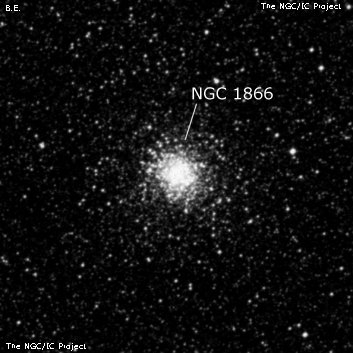
James Dunlop discovered NGC 1866 = D 247 = D 248 on 3 Aug 1826 and described (for D 247) "a pretty bright round nebula, 40" diameter." His position for this entry (1 observation) is 10' too far NW. Dunlop described D 248 as "a pretty bright round well-defined nebula, about 30" diameter, gradually brighter to the centre." He claims 3 observations for this object and the published position is 9' too far east. Since both descriptions are quite similar and this is the only bright object in the vicinity, it's reasonable to assume D 247 = D 248 = NGC 1866. John Herschel described NGC 1866 = h2793) as "vB; L; R; vgmbM; 2'; resolvable." and listed both Dunlop entries as possible equivalences. In 1926, Robert Innes described the cluster as "fine cluster of stars, very dense, with outliers, 2' diam, a miniature of Omega Centauri, 8th mag." (26-inch refractor, Union Observatory).
300/350mm - 13.1" (2/17/04 - Costa Rica): at 166x, this LMC globular appeared moderately bright and fairly large large, round, 2.5' diameter. The appearance was symmetrical with a faint 2.5' halo increasing to a 1' bright core which was concentrated to the center. There was no obvious resolution although the surface was grainy or mottled. Forms an equilateral triangle with a mag 11-12 star 3' WNW and a mag 12-13 star 3' NNW. This is a young populous "blue globular" with an age of roughly 100 million years.
600/800mm - 30" (11/6/10 - Coonabarabran, 264x): beautiful, highly resolved "blue globular" in the LMC. Appeared very bright, very large, with an intense 1' core surrounded by a 5' halo containing a few dozen very faint stars. The core itself was partially resolved into a number of densely packed stars over bright, mottled haze. NGC 1859 lies 18' NW.
Notes by Steve Gottlieb